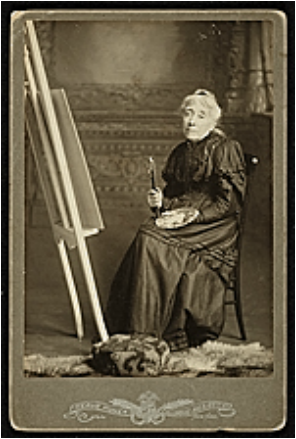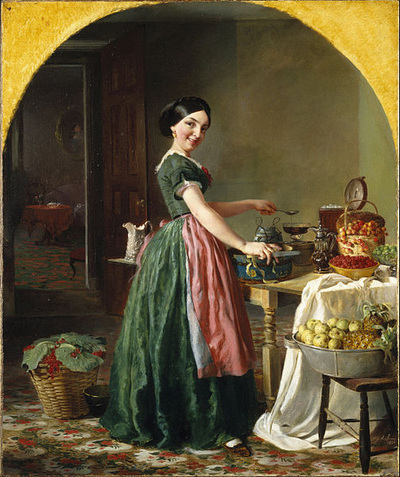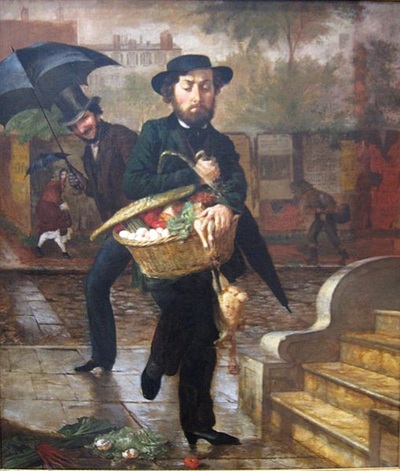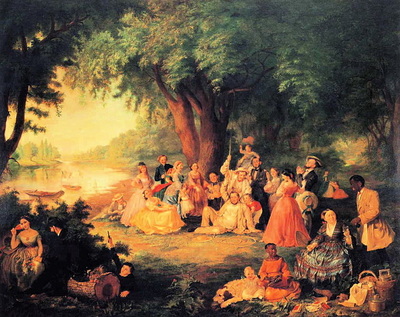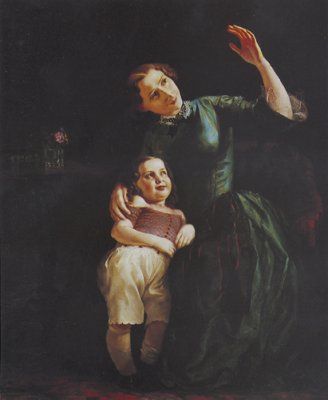LILLY MARTIN SPENCER 1822 - 1902
Angelique Marie Martin (known as Lilly), was born in 1822 in Exeter in the United Kingdom. In 1830 her family emigrated to New York, and three years later they settled in Marietta, Ohio. Her French-born parents, Gilles Marie Martin and Angelique Perrine LePetit Martin, encouraged her interest in art. Angelique in particular, as a follower of the French social theorist Charles Fourier, shaped her daughter’s belief in the equality of men and women. Lilly’s first exhibition was held in 1841 in the rectory of St Luke’s Episcopal Church in Marietta and attracted a lot of attention. Nicholas Longworth, a wealthy art patron, subsequently offered her financial support and the chance to study art in Europe, but she turned it down. Instead she organised her own studies and received help and tuition from local artists such as Charles Sullivan and Sala Bosworth. In 1844 Lilly married an Englishman, Benjamin Rush Spencer, in Cincinnati. After they were married, Benjamin gave up his own career and from then on worked alongside Lilly as her assistant, and he also ran the household. The couple had 13 children, 7 of whom survived to adulthood. 1848 Moved to New York City Lilly Martin Spencer was already quite well known in New York City by the time she moved there in 1848, having previously taken part in exhibitions at the National Academy of Design and the American Art-Union. The warm, welcoming atmosphere conveyed in her depictions of domestic scenes went down very well with viewers and were described as “positive”, “charming” and “humorous”. Women figured largely in her family-oriented images and portraits of maids, children and their mothers. Any income from sales of her pictures went towards supporting Lilly Martin Spencer’s family. Although she was one of the most popular and widely reproduced genre painters in the mid-19th century, this did not guarantee financial success. She received no share of the profits from sales of lithographic reproductions of her works, benefitting only from the sale of the image rights. The paintings themselves were mainly sold through artists’ associations, so when these became less popular she suffered a significant drop in income. And while she was commissioned to produce illustrations for magazines and books such as Godey’s Lady’s Book and The Women of the American Revolution, this did not bring in enough to live on. 1858 Moved to New Jersey. 1879–80 Returned to New York City Lilly Martin Spencer gradually broadened the thematic scope of her work. One particularly noteworthy piece is “Height of Fashion” (1854), which depicts an African-American girl holding a pet dog and a makeshift monocle. The image of the young black girl in an off-the-shoulder dress is intended as a humorous reference to social conventions. “War Spirit at Home” (1866) is a depiction of family life during the Civil War: the woman reading a newspaper represents female knowledge in a male-dominated society. “We Both Must Fade” (1869) shows a young woman looking at the reflected image of her beauty, for which she will earn the praise of others. In this way, Martin Spencer dared to present her individual perspective on contemporary society and women’s place within it. The allusions in her works to traditional female roles can be interpreted both as idealised portrayals and as utopian visions. Lilly Martin Spencer’s artistic career spanned more than 60 years and she continued working right up to her death in May 1902. Heidi Sill Quellen: „Godey's Lady's Book“, US-Frauenzeitschrift von 1830 - 1878 Herausgeber: Louis A. Godey, Philadelphia „The Women of the American Revolution“, 1845, drei Bände Herausgeberin: Elizabeth Fries Lummis Ellet, New York Charles Fourier, Nicholas Longworth, Charles Sullivan, Sala Bosworth |
LILLY MARTIN SPENCER 1822 - 1902
Angelique Marie Martin (Spitzname Lilly) wurde 1822 in Exeter, England geboren. 1830 immigrierte sie mit ihrer Familie nach New York, drei Jahre später zogen sie nach Marietta, Ohio. Ihre in Frankreich geborenen Eltern (Gilles Marie Martin und Angelique Perrine LePetit Martin) förderten ihre Hingabe zur Kunst und insbesondere ihre Mutter, als Anhängerin des französischen Gesellschaftstheoretikers Charles Fourier, prägten ihren Glauben für die Gleichberechtigung von Mann und Frau. Bereits ihre erste Ausstellung 1841 in dem Pfarrhaus St. Luke's Rectory in Marietta erregte viel Aufmerksamkeit, doch eine finanzielle Unterstützung sowie die Möglichkeit eines Kunststudiums in Europa, durch den Kunstmäzen Nicholas Longworth, schlug sie aus. Stattdessen studierte sie auf eigene Faust und holte sich Unterstützung der lokalen Künstler Charles Sullivan und Sala Bosworth. 1844 heiratete sie in Cincinnati den Engländer Benjamin Rush Spencer, der mit der Heirat seine eigene Karriere aufgab und ihr stattdessen als Assistent, Hausmann und Kinderbetreuer – von den dreizehn Kinder erreichten sieben das Erwachsenenalter - zur Seite stand. 1848 Umzug nach New York. In New York war sie durch Ausstellungsbeteiligungen in der „National Academy of Design“ und in der „American Art-Union“ bereits bekannt, und ihre „positiven“, „liebreizenden“, „humorvollen“ Bildszenarien von Häuslichkeit und warmer Atmosphäre kamen gut an. Familienszenen, Portraits von Hausmädchen, Kindern und Frauen, und damit vor allem die Frauen, standen im Mittelpunkt ihrer Werke. Lilly Martin Spencer finanzierte mit dem Verkauf ihrer Bilder die Familie und wurde zu einer der populärsten und der am häufigsten reproduzierten Genremalerinnen in der Mitte des 19. Jahrhunderts. Jedoch war ihre Popularität nur ein scheinbarer finanzieller Erfolg: An dem Verkauf der zahlreichen Lithographien wurde sie nicht beteiligt. Sie erzielte lediglich Einnahmen durch den Verkauf der Bildrechte an ihren Gemälden, und der Verkauf ihrer Gemälde sank durch den Niedergang der Künstlervereinigungen, über die sie überwiegend verkaufte. Mit Illustrationen, die sie für Zeitschriften wie „Godeys Lady's Book“ und „The Women of the American Revolution“ machte, konnte sie sich sicherlich nicht finanzieren. 1858 Umzug nach New Jersey. 1879-80 Umzug nach New York. Martin Spencer erweitert ihr Spektrum. Besonders hervorgehoben sei „Height of Fashion" (1854), in dem ein afroamerikanisches Mädchen mit einem Haustier und einem gefälschten Monokel dargestellt wird. Eine junge schwarze Frau in einem weißen Kleid, das über ihre Schulter fällt, verweist sehr humoristisch auf den moralischen Kontext einer Gesellschaft. „War Spirit at Home“ (1866) zeigt das Leben einer Bürgerkriegsfrau in der Familie: Die Frau steht als zeitungslesendes und damit wissendes Symbol für Erkenntnis in einer männlich dominierten Öffentlichkeit. „We Both Must Fade“ (1869) beschreibt den Blick einer Frau in den Spiegel, für den sie von anderen gelobt wird. Lilly Martin Spencer wagt damit auch einen Blick auf die Gesellschaft und kommentiert die Bedeutung von Frauen in der Gesellschaft. Die in ihren Werken enthaltenen Anspielungen auf die traditionelle Frauenrolle in der Gesellschaft kann man sowohl als idealisierte als auch utopische Darstellungen begreifen. Nach mehr als 60 Jahren künstlerischen Schaffens starb Lilly Martin Spencer 1902 in New York. Heidi Sill Quellen: „Godey's Lady's Book“, US-Frauenzeitschrift von 1830 - 1878 Herausgeber: Louis A. Godey, Philadelphia „The Women of the American Revolution“, 1845, drei Bände Herausgeberin: Elizabeth Fries Lummis Ellet, New York Charles Fourier, Nicholas Longworth, Charles Sullivan, Sala Bosworth |
